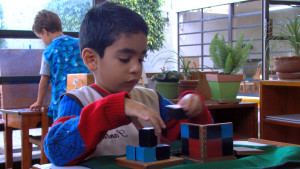
Sustainability seems to be a current buzzword. Product labels proclaim sustainability. Clothing is sustainable. Tuna is sustainable. New construction is sustainable.
Marketing types seem to be playing upon our ecological concerns of making sure we don’t run out of resources, that we aren’t unwittingly spending our grandchildren’s inheritance.
When I opened my first Montessori classroom, many friends went through their schools’ storerooms and sent me materials that were serviceable but well loved. With one set of wooden puzzle cubes I received a note: These are at least 25 years old. Perhaps a coat of paint will make them useful again.
A few coats of paint did the job. One day a student came to me sad-eyed to show me that someone had written on one of the cubes and scratched the paint. My student asked for me to call a class meeting.
“This is our binomial cube that we all love to work with. It was given to me by a friend in Philadelphia and was used by the children in her school for 25 years. My daughters used this cube. Some of your older brothers and sisters used this cube. I would like for your baby brothers and sisters to use this cube. How are we going to make sure that our brothers and sisters who aren’t even walking, maybe not even born yet, will be able to use this puzzle?”
Fifteen years later, the puzzles were still in service, giving another generation hands-on experience with algebra formulas.
These puzzle cubes represent one of the underlying concepts that endear me to working in a Montessori classroom: the idea of leaving an activity ready for the next person.
A Montessori classroom is lined with shelves full of hands-on learning materials. For three to six-year-olds the materials needed for each activity are grouped together on a tray or in a basket, and activities follow a left to right sequence on the shelves. A place for everything and everything in its place is true in a Montessori classroom.
After a child finishes working with any activity, he or she is responsible for returning it to good order and replacing the materials to their spots. Part of the clean up activity is to look around your work area and make sure that your friends won’t sit on a wet chair that you might have finished washing, or place their papers on a table that might have splatters of paint, while checking for any object you might have missed.
Every activity is left ready for the next person. The teacher helps guide the child to return his or her work to serviceable order, clean and restocked with the necessary materials. For example, a watercolor lesson would have clean paints, brushes and fresh paper on a dry tray.
Perhaps if we can, from the start, teach our children at home, at school, and in our larger communities to think and take the time to leave things ready for the next person, we’ll create a sustainable world.


Yes! This concept is unconsciously imbibed into the Montessori kids!
And a class meeting to have a way to speak up for a dear cause, make it an amazingly unique place to grow up!
Thank you Maren for shedding light onto something so natural in the Montessori classroom.